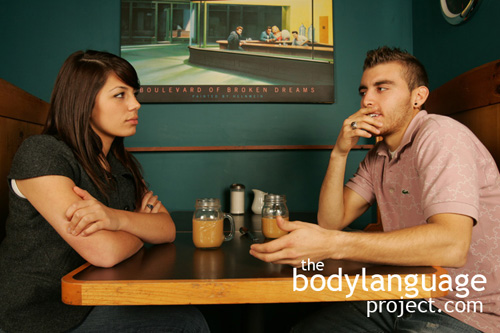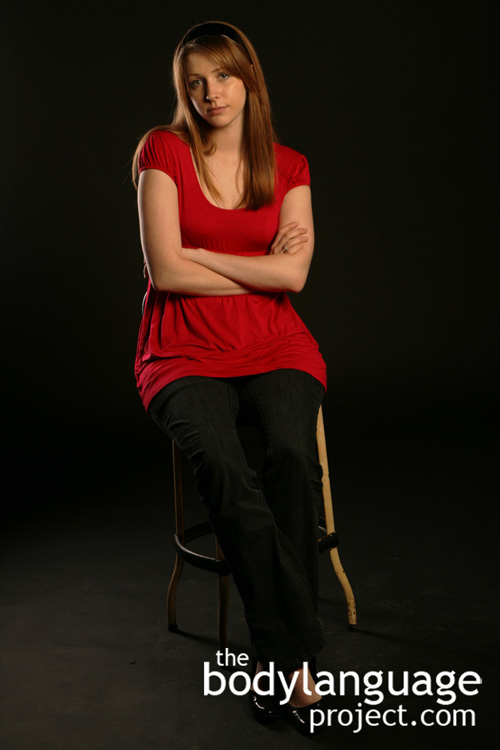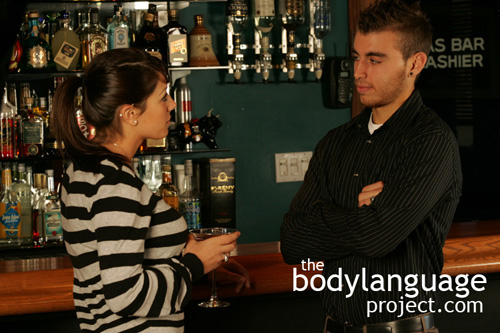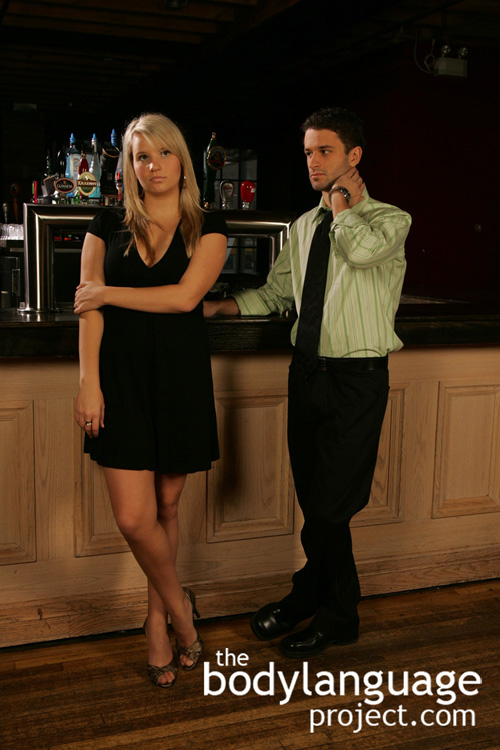Body Language Of Coffee Cup Barrier Or Handbag Barrier
 Cue: Coffee Cup Barrier or Handbag Barrier
Cue: Coffee Cup Barrier or Handbag Barrier
Synonym(s): Barriers, Drink Barrier, Blocking, Shields, Handbag Barrier, Placing Objects In Front, Hiding Behind Objects, Clutching A Jacket Over The Chest, Books Over The Chest, Hugging Books, Hugging A Jacket.
Description: While sitting or standing, a drink is held across the front of the body as if the arms were crossed.
In One Sentence: Blocking the body off with a barrier such as a cup of coffee is a way to partially block off the body from outside interference.
How To Use it: While is it generally advised to keep the body open to others, one can send a message of caution to others by holding a drink horizontally in front of the body to create a barrier. This will help you feel more comfortable by maintain separation.
In a dating context, the barrier can be used by women to show men that they are not willing to develop high intimacy. When a drink is not available, one can grasp the other wrist or play with a wrist band, watch, or for men, a cufflink.
These cues should be avoided when one wishes to appear confident, however.
Context: a) General b) Dating c) Business
Verbal Translation: “I’m using my drink or other object in a masked arm cross to give me protective feelings because I feel uneasy and exposed.”
Variant: Any object such as a purse, book, binder or papers, or jacket can be held against the chest to act as a protective devise. The cufflink or a wristwatch can also be played with to create another masked arm cross. See Masked Arm Cross.
Cue In Action: a) As Dave and Jim sat at dinner, they each held their glass on the opposite side and rested their arm across the table to maintain separation. b) While socializing with an attractive woman, he held his beer at chest level across the front of his body. c) When it came time to decide on the deal, she took a sip of her coffee and placed it back on the table. This time it was on the opposite side and she held her forearm across the table. He new she wasn’t going to come to a favourable decision.
Meaning and/or Motivation: Holding an object across the body is a way to cross the arms without actually crossing them. It is a way that people can appear to be open, but still find the security of cutting off the body from perceived attack. Holding a drink across the body as barrier is a closed body position, which is either unintentional and done out of habit, or is actually a signal indicating a negative thought.
Many times people will find drinks at social gatherings when first arriving. An alcoholic drink not only gives them more social confidence but also gives their hands something to do and more importantly it helps form a barrier across their chest, keeping people at a distance.
If the cue is done routinely, then it usually only indicates a mild need for security and protection afforded by a barrier. If it happens suddenly such as during a negotiation, it often indicates that a person has cooled to an idea and it will likely be met with rejection.
Cue Cluster: Watch for other negative or insecure body language such as touching the face, leaning away, feet pointed away, cowering, blushing, turning the torso away and so forth to decide just how much a person wishes to protect themselves.
Body Language Category: Barriers, Body cross, Masked body language, Negative body language, Closed body language, Security blankets.
Resources:
Bernstein, Constance. Winning trials nonverbally: six ways to establish control in the courtroom. Trial. 1994. 30(1).61(5).
Beaulieu, Catherine. Intercultural Study of Personal Space: A Case Study. Journal of Applied Social Psychology. 2004 34(4):794-805.
Balzarotti, Stefania ; Piccini, Luca ; Andreoni, Giuseppe ; Ciceri, Rita “I Know That You Know How I Feel”: Behavioral and Physiological Signals Demonstrate Emotional Attunement While Interacting with a Computer Simulating Emotional Intelligence. Journal of Nonverbal Behavior. 2014. 38(3): 283-299.
Brownell, Judi. Communicating with credibility: The gender gap. Cornell Hotel and Restaurant Administration Quarterly. 1993. 34(2): 52-61.
Baxter, James C., and Richard M. Rozelle (1975). “Nonverbal Expression as a Function of Crowding During a Simulated Police-Citizen Encounter.” In Journal of Personality and Social Psychology (Vol. 32, No. 1), pp. 40-54.
Cacioppo, J. T., Priester, J. R., & Berntson, G. G. (1993). Rudimentary determinants of attitudes: II. Arm flexion and extension have differential effects on attitudes. Journal of Personality and Social Psychology, 65, 5–17.
Cuddy, Amy J.C. ; Glick, Peter ; Beninger, Anna. The dynamics of warmth and competence judgments, and their outcomes in organizations. Research in Organizational Behavior. 2011. 31: 73-98.
Dolphin, Carol Zinner. Beyond hall: Variables in the use of personal space in intercultural transactions. Howard Journal of Communications. 1988. 1(1): 23-38.
Desteno, David ; Breazeal, Cynthia ; Frank, Robert H ; Pizarro, David ; Baumann, Jolie ; Dickens, Leah ; Lee, Jin Joo. Detecting the Trustworthiness of Novel Partners in Economic Exchange. Psychological Science. 2012. 23(12): 1549-1556.
Edinger, Joyce A. ; Patterson, Miles L. Zeaman, David (editor). Nonverbal involvement and social control. Psychological Bulletin. 1983. 93(1): 30-56.
Fatt, James P. T. It’s not what you say, it’s how you say it.(nonverbal communication). Communication World. 1999. 16(6): 37(4).
Fo¨rster, J. (2004). How body feedback influences consumer’s evaluation of products. Journal of Consumer Psychology, 14, 415–425.
Friedman, R. S., & Fo¨rster, J. (2000). The effects of approach and avoidance motor actions on the elements of creative insight. Journal of Personality and Social Psychology, 79, 477–492.
Greenberg, Carl I. ; Firestone, Ira J. Greenwald, Anthony G. (editor). Compensatory responses to crowding: Effects of personal space intrusion and privacy reduction. Journal of Personality and Social Psychology. 1977. 35(9): 637-644.
Graziano, Michael S.A. and Cooke, Dylan F. Parieto-frontal interactions, personal space, and defensive behavior. Neuropsychologia. 2006. 44(6): 845-859.
Holt, Daphne J ; Cassidy, Brittany S ; Yue, Xiaomin ; Rauch, Scott L ; Boeke, Emily A ; Nasr, Shahin ; Tootell, Roger B H ; Coombs, Garth. Neural correlates of personal space intrusion. The Journal of neuroscience : the official journal of the Society for Neuroscience. 2014. 34(12): 4123-34.
Johansson-Stenmen, O. (2008). Who are the trustworthy, we think? Journal of Economic Behavior & Organization, 68, 456–465. doi:10.1016/j.jebo.2008.08.004
Koppensteiner, Markus ; Grammer, Karl. Body movements of male and female speakers and their influence on perceptions of personality. Personality and Individual Differences. 2011. 51(6): 743-747.
Koppensteiner, Markus ; Stephan, Pia ; Jäschke, Johannes Paul Michael. From body motion to cheers: Speakers’ body movements as predictors of applause. Personality and Individual Differences. 2015. 74: 182-185.
Leigh, Thomas W. ; Summers, John O. An initial evaluation of industrial buyers’ impressions of salespersons’ nonverbal cues. Journal of Personal Selling & Sales Management. 2002. 22(1): 41(13).
Laird, J. D., Wagener, J. J., Halal, M., & Szegda, M. (1982). Remembering what you feel: Effects of emotion on memory. Journal of Personality and Social Psychology, 42, 646–657.
Mehrabian, Albert ; Williams, Martin Mcguire, William J. (editor). Nonverbal concomitants of perceived and intended persuasiveness. Journal of Personality and Social Psychology. 1969. 13(1): 37-58.
Mcelroy, James C. ; Morrow, Paula C. Personal space, personal appearance, and personal selling. Psychological Reports. 1994 74(2): 425(2).
Mcgurk, Barry J. ; Davis, John D. ; Grehan, John. Assaultive behavior personality and personal space. Aggressive Behavior. 1981. 7(4): 317-324.
Morris, Desmond (1994). Bodytalk: The Meaning of Human Gestures (New York: Crown Publishers).
Newman, Robert C. ; Pollack, Donald Holzberg, Jules D. (editor). Proxemics in deviant adolescents. Journal of Consulting and Clinical Psychology. 1973 40(1): 6-8.
Neumann, R., & Strack, F. (2000). Approach and avoidance: The influence of proprioceptive and exteroceptive cues on encoding of affective information. Journal of Personality and Social Psychology, 79, 39–48.
Navarro, Joe. 2008. What Every BODY is Saying: An Ex-FBI Agent’s Guide to Speed-Reading People. William Morrow Paperbacks
Pease, Barbara and Allan Pease. 2006. The Definitive Book of Body Language Hardcover. Bantam.
Riskind, J. H., & Gotay, C. C. (1982). Physical posture: Could it have regulatory or feedback effects upon motivation and emotion? Motivation and Emotion, 6, 273–296.
Roll, William V. ; Schmidt, Lyle D. ; Kaul, Theodore J. Berdie, Ralph F. (editor). Perceived interviewer trustworthiness among black and white convicts. Journal of Counseling Psychology. 1972. 19(6): 537-541.
Ryan, Mary E. Good nonverbal communication skills can reduce stress. (Law Office Management). Trial. 1995. 31(1): 70(5).
Richmond, Virginia P., James C. McCroskey and Steven K. Payne (1991). Nonverbal Behavior in Interpersonal Relations (2nd Ed., Englewood Cliffs, New Jersey: Prentice Hall).
Sharpley, Christopher F ; Halat, Jennifer ; Rabinowicz, Tammy ; Weiland, Birgit ; Stafford, Jane. Standard posture, postural mirroring and client-perceived rapport. Counselling Psychology Quarterly. 2001. 14(4): 267-280.
Stepper, S., & Strack, F. (1993). Proprioceptive determinants of emotional and nonemotional feelings. Journal of Personality and Social Psychology, 64, 211–220.
Tamir, M., Robinson, M. D., Clore, G. L., Martin, L. L., & Whitaker, D. J. (2004). Are we puppets on a string? The contextual meaning of unconscious expressive cues. Personality and Social Psychology Bulletin, 30, 237–249.
Werner, Carol ; Brown, Barbara ; Damron, Gary Steiner, Ivan D. (editor). Territorial marking in a game arcade. Journal of Personality and Social Psychology. 1981. 41(6): 1094-1104.
Vrugt, Anneke, and Ada Kerkstra (1984). “Sex Differences in Nonverbal Communication.” In Semiotica (50-1/2), pp. 1-41.
Yuksel, Atila. Nonverbal Service Behavior and Customer’s Affective Assessment. Journal of Quality Assurance in Hospitality & Tourism. 2008. 9(1): 57-77.





